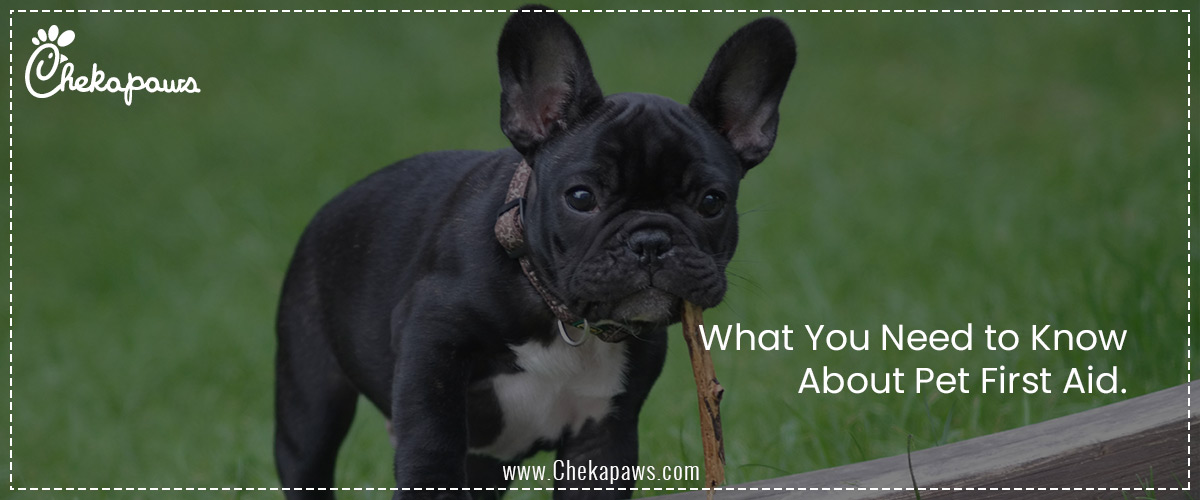As devoted pet owners, we share our lives with our feathered, scaled, or furry friends and work hard to provide them with the highest quality of care. We purchase wholesome food, arrange for routine veterinary examinations, give daily exercise, and show them a lot of love and care. However, crises can occur unexpectedly and without notice. Knowing how to react quickly and efficiently might mean the difference between life and death, whether your dog cuts its paw on broken glass while out for a stroll, your cat ingest something poisonous, or your rabbit exhibits symptoms of heatstroke.
Pet first aid is an essential first step in keeping your pet stable until help arrives, but it cannot replace professional veterinarian care. The initial moments following an accident or the development of symptoms are frequently the most critical, much like with people. Your pet’s life could be saved or more issues could be avoided if you are prepared to respond coolly and effectively.
Many pet emergencies happen on the weekends, on holidays, or in isolated locations when a veterinarian is not immediately available. In these situations, having the information and resources you need on hand enables you to act quickly and intelligently. A good pet owner must be able to recognise critical symptoms, construct an emergency kit specifically for their pet, understand basic first aid, and know when to call the veterinarian.
Everything you need to know about pet first aid will be covered in this extensive guide, from putting together your bag to dealing with life-threatening situations including choking, poisoning, and seizures. Additionally, you will learn pet CPR, pet-specific advice, and how to be ready for situations in advance.
Table of Contents

Understanding Pet First Aid Basics
Understanding what pet first aid entails and how it varies from routine care is crucial before we talk about specific injuries or emergencies.
What Is Pet First Aid?
Until complete veterinary care is available, pet first aid is the initial care given to an animal that is ill or injured. It’s a way to stabilize and safeguard your pet, not a cure.
- This could consist of:
- Halting the bleeding.
- Rendering wounded limbs immobile.
- Avoiding shock.
- Eliminating toxins from skin or fur.
- Carrying out cardiopulmonary resuscitation.
Why It Matters
Animals are unable to communicate their anguish, and many of them naturally conceal their illnesses. Therefore, it is essential that you:
- Identify small indications of concern.
- Understand your pet’s typical behaviour.
- When something goes awry, take quick action.
Learn your pet’s Normal Vital
- Become at ease with your pet
- Heart rate: 140–220 bpm for cats, 60–140 bpm for dogs, depending on size.
- Dogs breathe 10–35 times per minute, while cats breathe 20–30 times per minute.
- Temperature range for cats and dogs: 37.8–39.2°C (100–102.5°F).
- Gum should be wet and pink.
Any notable break from these standards could indicate an issue.
Signs of an Emergency to Look Out for
Give your veterinarian a call right away if your pet:
- Becomes unresponsive or collapses.
- Has trouble breathing or, in the case of cats, open-mouth breathing.
- Has bloody diarrhoea or is throwing up.
- Displays symptoms of severe discomfort.
- Has gums that are yellow, blue, or pale.
- Has seizures.
- Incapable of walking or standing.
Essential Pet First Aid Kit
Your first line of safety should be a fully equipped first aid pack. A pre-made kit is available for purchase, or you can put one together yourself. In any case, ensure sure it’s lightweight, properly labelled, and updated frequently.
Essential Materials
- Gauze rolls and pads: For muzzling or bandaging wounds.
- Bandages that don’t attach to fur can be used to protect wounds.
- Self-sticking wrap, such as Vet Wrap to keep dressings in position.
- To secure gauze, use adhesive tape.
- Rectal temperature can be taken with a digital thermometer.
- Chlorhexidine or betadine are antiseptic wipes or solutions used to clean wounds.
- Tweezers: Used to extract trash, ticks, and splinters.
- Blunt-tipped scissors: Used to cut fur or bandages.
- Non-latex gloves: To protect both you and your pet.
- To stop minor bleeding, particularly from cuts on the nails, use styptic powder or pencil.
- To rinse, use saline or eye wash.
- To rinse out wounds or eyes, use saline or eye wash.
- A turkey baster or oral syringe is used to give fluids.
- Warm and cold packs: For hypothermia or oedema.
- Use hydrogen peroxide (3%) only as directed by a veterinarian to induce vomiting.
- Toxins can be absorbed with activated charcoal (only as indicated).
- Muzzle: When in distress, even the kindest pet may bite.
- To help with restraint or transportation, use a leash and tow
Optional but Helpful Items
- Flashlight with extra batteries.
- Emergency blanket.
- Tick remover.
- Nail clippers.
- Benadryl (diphenhydramine)—ask your vet for dosage.
- A pet first aid manual.
- List of emergency vet contacts.
Pet-Specific Additions
- Cats: Cat-specific muzzle, smaller thermometer, hairball remedies.
- Dogs: Booties for paw protection, larger bandages.
- Exotics: Special heat sources, tiny feeding syringes.
- Keep your kit in a central location, and make a smaller travel version for your car.
- A guide to first aid for pets.
- Contacts for emergency veterinarian care.
Additions Particular to Pets
Cats: hairball treatments, a smaller thermometer, and a muzzle designed specifically for cats.
How to Handle Common Pet Emergencies
Here are some tips for managing some of the most common—and terrifying—pet crises until aid from a specialist can be obtained.
External Bleeding
How to proceed:
- Put a muzzle on your pet if needed.
- Use a clean rag or gauze to apply direct pressure.
- See a veterinarian right away if the bleeding doesn’t stop in ten minutes.
Don’t
- Remove items that are deeply embedded.
- Use a tourniquet only if it is absolutely required.
Signs of Choking
- Pawing at the mouth.
- Drooling or gagging.
- Gums or lips that are blue.
What to do
If the object is visible, carefully open the mouth and attempt to remove it.
Otherwise, administer the Heimlich:
- For little pets, hold upside down and firmly press upward beneath the ribs.
- Pets that are large should stand behind, thrust upward, and lay their hands directly below their ribs.
Then, rush to a vet.
Poisoning
Common toxins:
- Chocolate.
- Raisins or grapes.
- Xylitol (found in peanut butter and gum).
- Human medications.
- Cleaners for the home.
- Some plants (sago palms, lilies, etc.).
How to proceed:
- Contact poison control or your veterinarian.
- If not directed, do not cause vomiting.
- Don’t forget the product label.
Seizures
How to proceed:
- Protect your pet from injury.
- Keep your hands off their mouth.
- Keep track of the seizure.
- Maintain their composure and coolness after the seizure.
- When a seizure occurs for the first time or lasts more than a minute, call the veterinarian right away.
Heatstroke
Symptoms:
- Excessive panting.
- Drooling.
- Weakness.
- Vomiting.
- Bright red gums.
How to proceed
- Go somewhere cool.
- Put cool (not cold) water on your paws and tummy.
- If conscious, offer water.
- Avoid using ice. See a veterinarian immediately.
Hypothermia
Symptoms:
- Shivering.
- Lethargy.
- Cold ears/paws.
- What to do:
- Wrap in warm blankets or towels.
- Use warm water bottles (wrapped) near body.
- Transport to vet.
Broken Bones
How to proceed:
- Keep your pet as motionless as you can.
- Gently muzzle them.
- Avoid attempting to realign bones.
- For transportation, place on a level surface.
Insect Bites/Stings
Symptoms
- Swelling.
- Redness.
- Hives.
- Breathing difficulties.
What to do
- If there is a stinger, use a card to remove it.
- Put on a cold compress.
- If your veterinarian has approved it, give an antihistamine.
CPR for Pets
When to Apply CPR
- Do CPR only if your pet is:
- unconscious.
- Not breathing.
- No pulse.
CPR for Dogs and Cats
- Call their name and tap.
- Check the pulse and breathing if there is no reaction.
Positioning
- Place your pet on their right side.
Chest Compressions
- For cats and small dogs, pressure the chest 1 inch with one hand at a speed of 100–120 beats per minute.
- For medium-to-large dogs, place two hands over the chest’s widest area.
Rescue Breaths
- Stop your mouth.
- After every 30 compressions, breathe into the nose.
- Make sure your chest raises.
Continue Until
- You reach a vet.
- They regain a heartbeat.
- You are exhausted.
Learn hands-on CPR from pet first aid classes if possible.
Pet-Specific First Aid Tips
Dogs
- Bloat: enlarged abdomen, vomiting attempts. Visit the veterinarian right away.
- Clean and bandage any paw injuries. When walking is required, use booties.
- Use veterinarian-approved cleaning products for ear injuries.
Cats
- Injuries should be watched for signs of lethargy, hiding, or limping.
- Battles: Clean up wounds, particularly abscesses.
- If a string or toy chokes, don’t pull; instead, call a veterinarian..
Exotic Pets
- Birds are fragile exotic pets; don’t put them in close confines. If they are cold, warm them up.
- Keep an eye out for burns or dehydration in reptiles.
- Guinea pigs and rabbits: Never make them throw up.
- Emergencies involving non-dog or non-cat animals should always be referred to an exotic veterinarian.
When to Seek Veterinary Help Immediately
While first aid is beneficial, some situations cannot wait.
- See a veterinarian if your pet is having trouble breathing.
- Is immobile or paralysed.
- Has been hit by a falling object.
- Has diarrhoea or vomiting that doesn’t go away.
- Ingested sharp objects or poison.
- Is seriously bleeding.
- Exhibits neurological symptoms, such as seizures and head tilt.
- Has significant wounds or burns.
Tips for Safe Transportation
- Maintain your pet’s composure.
- Make use of a towel sling, box, or carrier.
- Assist limbs that are wounded.
- Give the clinic advance notice so they can get ready.
Preparing for Emergencies
Keep Medical Records Handy
- Store medical records in an app or folder to keep them accessible.
- Include vaccination, allergies, meds, vet contact info.
Create a Pet Emergency Plan
- Get the closest 24-hour veterinarian.
- If you’re not there, make arrangements for someone to assist.
- Have emergency supplies on hand.
Train Yourself and Your Family
- Join in an in-person or online pet first aid course.
- Teach children to remain composed and to inform adults.
Stay Calm
Your pet follows your instructions in an emergency. Take a deep breath, maintain your composure, and concentrate on completing the most crucial tasks first.
Conclusion
Pet emergencies can be terrifying, but being ready is crucial. First aid equips you to take prompt action, maintain control, and maximise your pet’s chances of recovery. With the correct information, tools, and preparation, you can feel equipped to deal with anything from a minor injury to a life-threatening situation.
Keep in mind that you are your pet’s first responder. Be calm, learn, and be ready. Above all, cherish them each and every day.







